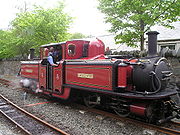
0-4-4-0
Encyclopedia

Whyte notation
The Whyte notation for classifying steam locomotives by wheel arrangement was devised by Frederick Methvan Whyte and came into use in the early twentieth century encouraged by an editorial in American Engineer and Railroad Journal...
for the classification of steam locomotive
Steam locomotive
A steam locomotive is a railway locomotive that produces its power through a steam engine. These locomotives are fueled by burning some combustible material, usually coal, wood or oil, to produce steam in a boiler, which drives the steam engine...
wheel arrangement
Wheel arrangement
In rail transport, a wheel arrangement is a system of classifying the way in which wheels are distributed beneath a locomotive.. Several notations exist to describe the wheel assemblies of a locomotive by type, position, and connections, with the adopted notations varying by country...
, a 0-4-4-0 is a locomotive with no leading truck, two sets of four driving wheel
Driving wheel
On a steam locomotive, a driving wheel is a powered wheel which is driven by the locomotive's pistons...
s, and no trailing truck. Examples of this type were constructed as Mallet
Mallet locomotive
The Mallet Locomotive is a type of articulated locomotive, invented by a Swiss engineer named Anatole Mallet ....
, Meyer
Meyer
- Companies :* Meyer Corporation* Fred Meyer, Inc., American hypermarket chain; currently a subsidiary of Kroger* Meyer Sound Laboratories- Places :* Meyer Township, Michigan* Meyer, Illinois, unincorporated community in Adams County, Illinois, USA...
and Double Fairlie locomotives. A similar configuration was used on some Garratt
Garratt
A Garratt is a type of steam locomotive that is articulated in three parts. Its boiler is mounted on the centre frame, and two steam engines are mounted on separate frames, one on each end of the boiler. Articulation permits larger locomotives to negotiate curves and lighter rails that might...
s, but it is referred to as 0-4-0+0-4-0
0-4-0+0-4-0
A 0-4-0+0-4-0, in the Whyte notation for the classification of steam locomotives by wheel arrangement, is an articulated locomotive, usually of the Garratt type. It features no leading or trailing wheels at either end, having only two sets of four driving wheels...
.
Equivalent classifications
Other equivalent classifications are:- UIC classificationUIC classificationThe UIC classification of locomotive axle arrangements describes the wheel arrangement of locomotives, multiple units and trams. It is set out in the International Union of Railways "Leaflet 650 - Standard designation of axle arrangement on locomotives and multiple-unit sets". It is used in much...
: BB (also known as German classification and Italian classification) - French classification: 020+020
- Turkish classificationTurkish classificationIn the Turkish classification system for railway locomotives, the number of powered axles are followed by the total number of axles. It is identical to the Swiss system except that the latter places a slash between the two numbers.Thus0-6-0 becomes 33...
: 22+22 - Swiss classification: 2/2+2/2
The UIC classification
UIC classification
The UIC classification of locomotive axle arrangements describes the wheel arrangement of locomotives, multiple units and trams. It is set out in the International Union of Railways "Leaflet 650 - Standard designation of axle arrangement on locomotives and multiple-unit sets". It is used in much...
is refined to B'B for a Mallet locomotive or B'B' for a Meyer locomotive.
Fairlie examples

Fairlie
A Fairlie is a type of articulated steam locomotive that has the driving wheels on bogies. The locomotive may be double-ended or single ended...
0-4-4-0 was built for the Neath and Brecon Railway
Neath and Brecon Railway
The Neath and Brecon Railway linked the Vale of Neath Railway at Neath with the Brecon and Merthyr Railway at Brecon and also via a connection from Colbren Junction, it linked to the Swansea Vale Railway at Ynysygeinon Junction ....
in 1866, but the design came to prominence in 1869 with Little Wonder for the Festiniog Railway in North Wales
Wales
Wales is a country that is part of the United Kingdom and the island of Great Britain, bordered by England to its east and the Atlantic Ocean and Irish Sea to its west. It has a population of three million, and a total area of 20,779 km²...
followed by five others. One locomotive was supplied to the Denver and Rio Grande Railroad in 1872. The type was also used in Mexico
Mexico
The United Mexican States , commonly known as Mexico , is a federal constitutional republic in North America. It is bordered on the north by the United States; on the south and west by the Pacific Ocean; on the southeast by Guatemala, Belize, and the Caribbean Sea; and on the east by the Gulf of...
, New Zealand
New Zealand
New Zealand is an island country in the south-western Pacific Ocean comprising two main landmasses and numerous smaller islands. The country is situated some east of Australia across the Tasman Sea, and roughly south of the Pacific island nations of New Caledonia, Fiji, and Tonga...
and Russia
Russia
Russia or , officially known as both Russia and the Russian Federation , is a country in northern Eurasia. It is a federal semi-presidential republic, comprising 83 federal subjects...
on Transcaucasian Railway.
Survivors
There are three examples of surviving Fairlie 0-4-4-0 locomotives on the Ffestiniog RailwayFfestiniog Railway rolling stock
The Ffestiniog Railway owns and operates a number of heritage and modern-day steam and diesel locomotives. A full list of these locomotives with details of their operational status is provided below.-Locomotives:...
the last of which was built in 1992.

